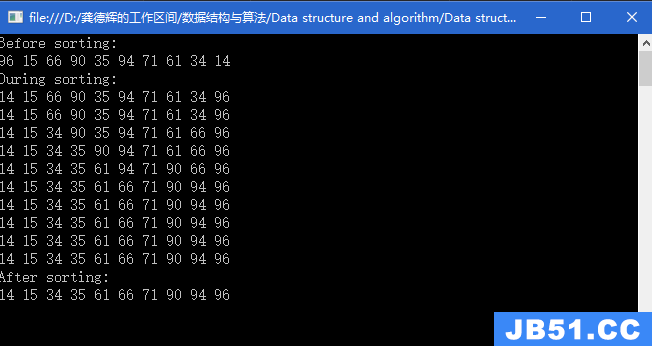学习数据结构基础,如有错误,请指正。
(图的广度优先遍历算法部分,存在错误,请高手帮小弟看下)
/************************************************************************
数据结构:图的实现,并对其进行深度优先、广度优先遍历
************************************************************************/
#ifndef __GRAPH_H__
#define __GRAPH_H__
typedef struct ArcNode_stru
{
int index;
struct ArcNode_stru *next;
} ArcNode;
typedef struct VNode_stru
{
int data;
ArcNode *firstArc;
} VNode;
class Graph
{
public:
Graph();
~Graph();
void creatGraph();
int firstAdj(int id);
int nextAdj(int id);
void depthFirstSearch(int id);
void breadthFirstSearch(int id);
void travel_DFS();
void travel_BFS();
private:
VNode G[5];
int visited[5];
};
#endif // __GRAPH_H__
#include "Graph.h"
#include <iostream>
#include <list>
using std::cout;
using std::cin;
using std::endl;
using std::list;
Graph::Graph()
{
creatGraph();
}
Graph::~Graph()
{
delete []G;
}
void Graph::creatGraph()
{
cout<<"input five vertex data:";
for (int i=0;i<5;++i)
{
cin>>G[i].data;
G[i].firstArc = NULL;
visited[i] = 0;
}
int e;
ArcNode *node,*preNode;
for (int i=0;i<5;++i)
{
cout<<"input "<<i+1<<"th vertex's edges:"<<endl;
cin>>e;
while(e != -1)
{
node = new ArcNode();
node->index = e;
node->next = NULL;
if (G[i].firstArc == NULL)
{
G[i].firstArc = node;
}
else
{
preNode->next = node;
}
preNode = node;
cin>>e;
}
} // end for
}
int Graph::firstAdj(int id)
{
if (G[id].firstArc != NULL)
{
return G[id].firstArc->index;
}
return -1;
}
int Graph::nextAdj(int id)
{
ArcNode *p = G[id].firstArc;
while (p != NULL)
{
if ( visited[p->index] == 1)
{
p = p->next;
}
else
{
return p->index;
}
}
return -1;
}
// 仅适用于连通图
void Graph::depthFirstSearch(int id)
{
cout<<G[id].data;
visited[id] = 1;
int tmp_id = this->firstAdj(id);
while( tmp_id != -1)
{
if (visited[tmp_id] == 0)
{
this->depthFirstSearch(tmp_id);
}
tmp_id = this->nextAdj(id);
}
}
// 仅适用于连通图
// 存在错误,请指教 void Graph::breadthFirstSearch(int id) { cout<<G[id].data; visited[id] = 1; int index = -1; list<int> *q = new list<int>; q->push_back(id); while(0 != q->size() ) { int count = q->size(); list <int>::iterator item = q->begin(); list <int>::iterator pre_item = q->begin(); for (;item!=q->end();++item) { pre_item = item; } index = *pre_item; int tmp = this->firstAdj(index); while (tmp != -1) { if (visited[tmp] == 0) { cout<<G[tmp].data; visited[tmp] = 1; q->push_back(tmp); } tmp = this->nextAdj(index); } tmp = this->nextAdj(index); } } void Graph::travel_DFS() { for (int i=0;i<5;++i) { if (visited[i] == 0) { this->depthFirstSearch(i); } } } void Graph::travel_BFS() { for (int i=0;i<5;++i) { if (visited[i] == 0) { this->breadthFirstSearch(i); } } } void main() { Graph *g = new Graph(); //g->travel_DFS(); g->travel_BFS(); getchar(); } // end


